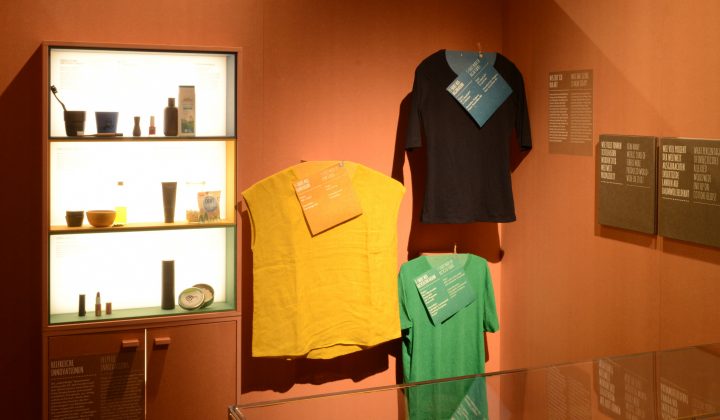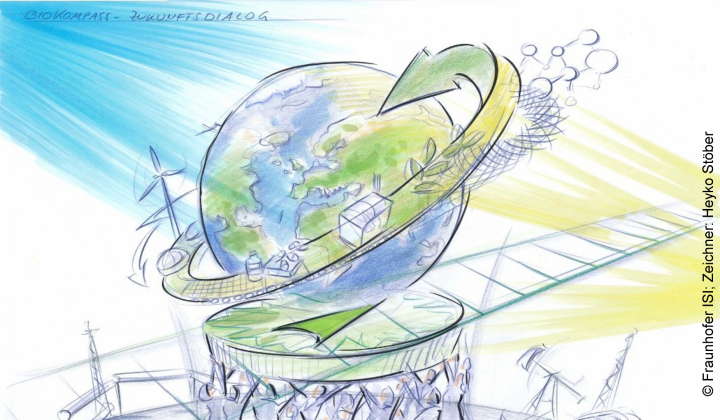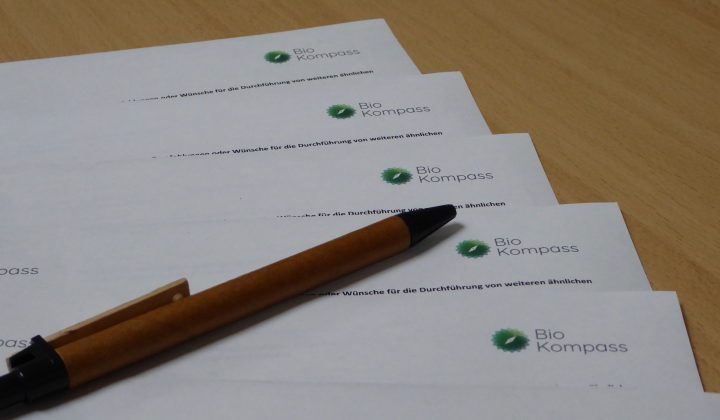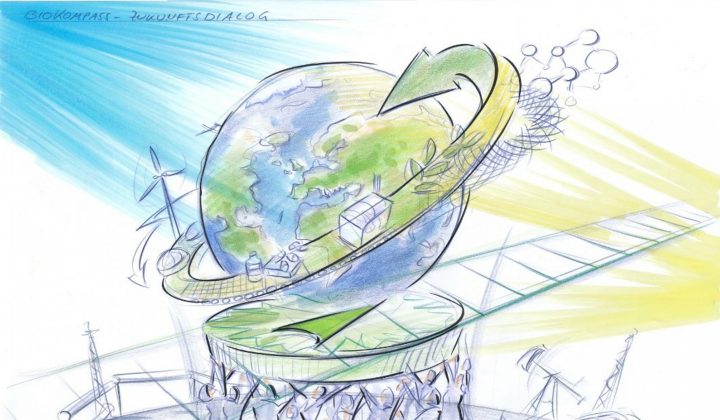Glossary
Project-specific technical terms
Technical terms in connection with bioeconomy
Agrobiodiversity
Refers to the biological diversity that is required for food production, agriculture, and an intact agroecosystem.
Aquaponics
A combination of fish and plant breeding in a closed cycle and the use of the resulting synergies, such as fish excrements as fertilizer for the plants, or water improvement or filtering by the plant population.
Augmented Reality (AR)
Expanded reality. Computer-supported additions to our reality by means of virtual objects and information in real time. Examples include superimposed lines or circles showing free kick distances during televised soccer games or the Pokémon Go computer game from the year 2016.
Auxiliary flows
Incidental materials incurred during a product’s manufacturing that cannot be used in the manufacturing of this product.
Bio-based products
Products that were created partially or entirely on the basis of renewable resources.
Biodiversity
Biological diversity. “The variability among living organisms from all sources, inter alia, terrestrial, marine and other aquatic ecosystems, and the ecological complexes of which they are part; this includes diversity within species, between species, and of ecosystems.” (UN Biodiversity Convention, Art. 2)
Bioeconomy
Bio-based economy. Utilization and generation of renewable resources on the basis of the latest scientific findings to provide products and processes in all areas of the economy. This is meant to enable the transition from an oil-based to a bio-based, sustainable economic system. The concept encompasses all sectors and areas that produce, utilize, or trade with plants, animals, and microorganisms. This includes agriculture and forestry, fisheries and aquaculture, timber and textile industries as well as parts of the chemical and pharmaceutical industry and the energy industry.
Biogenic
Originating from living or dead organic substances.
Biomass
The total mass of living organisms in a habitat. In an economic context: the total organic substance of animals, plants, and microorganisms that is generated or used in various branches of the economy.
Biorefinery
Analogous to an oil refinery, an industrial plant that processes renewable resources into various products, e.g., platform chemicals, bio-fuels, or materials.
Biotechnology
An application-oriented branch of biology that deals with the use of biological systems, living organisms or their products, and models in technical applications.
Ecological footprint
This sustainability indicator denotes the percentage of the earth’s surface permanently required by a single human due to his/her individual lifestyle. Mankind’s lifestyle is only sustainable if the ecological footprint = 1, since only one earth is available. However, the worldwide average is 1.6; in Germany, it even lies at 3.1 (as of 2016). This means that more than three earths would be needed if the entire world population were to live with the resource use recorded in Germany.
E-mobility
Electric mobility (e-mobility) is a form of mobility that uses vehicles driven by electric energy such as cars, buses, commercial vehicles, trains, bicycles and motorbikes, boats, and small airplanes. The electric energy is supplied via batteries, fuel cells, overhead lines, or hybrid drives.
Energetic use
The use of organic substances of biological origin (biomass) as a resource for energy production.
Evaluation
The systematic study and assessment of projects, processes, or formats by means of proper, professional methods such as surveys, observation, and analyses. In the context of BioKompass, the main focus is on accompanying the development of participation and communication formats and their continuous improvement.
Foresight
An instrument of future research that enables a strategic preview in long-term developments. This is achieved with the use of participative and discursive formats to examine the involvement with alternative developments.
Fossil resources
The earth’s carbon stores that are primarily extracted in the form of coal, oil, and natural gas. They arose from organic raw materials such as dead animals and plants over geological eras (millions of years) and cannot be regenerated within human dimensions. They currently constitute the most important energy sources for the economy, but their use negatively impacts the climate and environment.
Futures
Rarely used plural of future. Illustrates the wide variety of possible developmental paths.
Gene database
A database that stores the genetic information of a wide variety of different species and organisms.
GMO
Acronym for genetically modified organisms, i.e., organisms whose genetic material was altered using genetic engineering methods. These changes do not occur under natural conditions.
Green economy
An economic approach that “increases human well-being and ensures social justice while at the same time reducing risks to the environment and taking into account the scarcity of ecological resources.” (UNEP 20111)
Inorganic resources
Resources from the inanimate nature, e.g., iron, lime, salts, etc.
Integrated agricultural land use
The integrated land use aims to achieve an interaction between the protection and utilization of the landscape while realizing both at the same time. Alternative cultivation concepts make it possible to pursue both goals simultaneously.
In-vitro meat
Meat that was artificially created by means of tissue engineering in a bioreactor; it serves as an alternative to live animal husbandry.
Material use
The use of organic substances of biological origin (biomass) as raw materials for the production of goods.
Obsolescence
Naturally or artificially induced aging of a product, which therefore wears out more quickly and becomes unusable.
Ocean-based cultivation
(also called mariculture) The planned and controlled breeding of marine organisms (e.g., fishes, clams, algae) in an enclosed area within the ocean for use as food or in the production of other products.
Participation
Participation, attendance, co-determination, with the involvement of organizations or individual persons in the decision-making and design processes.
Permaculture
Permanent agriculture that works in natural cycles. It aims at sustainably safeguarding the basis of human life at the ecological, economic, and social level.
Planetary boundaries
A concept of earth system research that makes statements regarding the health of the earth and the basis of human life. The approach identifies nine key processes for the planet’s stability. If the respective boundaries of these processes are exceeded, e.g., by acidification of the oceans or species extinction, this may result in changes in the ecological framework conditions that could threaten the existence of future generations.
Platform chemicals
Industrial chemicals mass-produced on the basis of renewable resources that serve as starting materials for many other chemicals and industrial products.
Post-growth economy
A form of economy in which the people’s basic needs are met but which is not oriented toward economic growth. Compared to the current economic practices, this would lead to a reduction in consumption, resource use, and monetary value creation while realizing sustainable supply practices.
Precision farming/Smart farming
The use of intelligent, digital technologies for an efficient agriculture. Incorporating a wide range of information (nutrient content in the soil, harvest volumes from previous years, etc.) and localizing the position of the processing machines is intended to lead to a site-specific, resource-efficient, and more environmentally friendly cultivation.
Public transport
This comprises the transport of people in cities, suburbs, and in outlying areas using the scheduled service of trains and trams, buses, and boats. It must be differentiated from long-distance transport, freight transport, and individual travel.
Regenerative energies
A synonym for renewable energies. Energy sources with a virtually unlimited availability within the human temporal horizon, e.g., hydropower, solar, or wind energy.
Renewable resources
Resources from the agricultural and forestry production that are basic materials for industrial products or are used for energy production, and that do not serve as human food or animal fodder.
Scenario analysis
A method for analyzing possible developments of alternative future scenarios. To this end, impact factors are defined, and their development potential predicted to create possible future scenarios on this basis.
Sufficiency
This term denotes the conscious forgoing of a commodity and the associated changes in behavior, with the goal to meet the basic requirements while significantly reducing the use of resources and goods.
Sustainability
Sustainable actions at the economic, ecological and social level that satisfy the demands of the current generation while preserving the long-term potential for fulfilling the desires and requirements of future generations as well.
Value creation
The total sum of all goods and services manufactured in the individual economic sectors, minus the provided preliminary services.
Vertical farming
Vertical agriculture denotes an agricultural practice in urban areas where the production of animal and plant products occurs in specially designed high-rise complexes.




